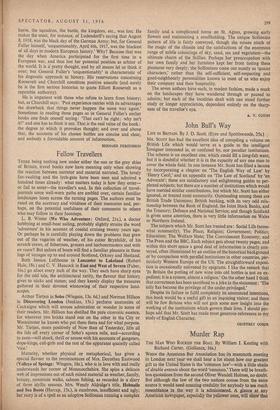Murder Rap
THE MAN WHO ROCKED THE BOAT. By William J. Keating with Richard Carter. (Gollancz, 16s.) WHEN the American Bar Association has its mammoth meeting in London next year we shall hear a lot about how our greatest gift to the United States is the `coinmon law'—with a little shade of double entente about the word 'common.' There will be breath- less quotations from the second Oliver Wendell Holmes, no doubt. But although the law of the two nations comes from the same source it would need amazing credulity for anybody to see much resemblance in the way it is administered. A glance at any American newspaper, especially the yellower ones, will show that the jaws a libel and contempt might be non-existent for any effect they have on reporters and editors and during the recurrent 'red scares' a this century it has been proved that even law derived direct from the sacred and written Constitution can be treated just as lightheartedly. The Man Who Rocked the Boat proclaims in every page that the common law as interpreted by the US judiciary, and especially as exploited by District Attorneys' offices, has become unrecognisable. The book is hard to read except for real enthusiasts about American manners and morals, but it is worth the effort because it shows that even when fighting against the most entrenched political interests a 'crusading' lawyer can still pin a murder rap on hoodlums who believe themselves to be completely protected from police interference.
Cinemagoers who have seen On the Waterfront will be aware of the special problems in New York, where trade unionism and gangsterism are sometimes difficult to sort out. Those who have also seen the more recent film The Killing will also know how much organising genius goes into American crime. The Iwo factors come together in the notorious 'Dunn case' which is the principal burden of Mr. Keating's book. He 'rocked the boat' in the sense that having discovered a particularly brutal murder, done for mixed trade union and criminal motives, he insisted on seeing justice upheld. In the course of what became, for him, a crusade, he lost his job and seemed in danger of losing his reputation as a lawyer. But if his description of the case and how it was fought is entirely accurate he came out of the dirty business with an even higher reputation. I cannot agree with what it says on the wrapper—that this is 'far more exciting than any fictional detective thriller . . . ,' but it is a factual account of how an American lawyer 'can, with courage and tenacity, see that the so-called ',coinmon law' is used against crime instead of being exploited by criminals for their own protection.
GEkARD PAY



































 Previous page
Previous page